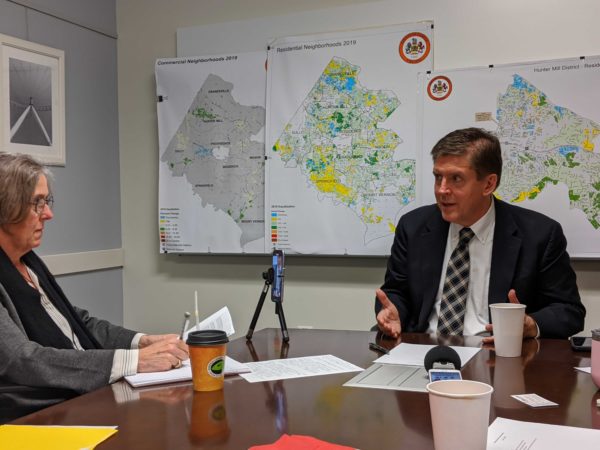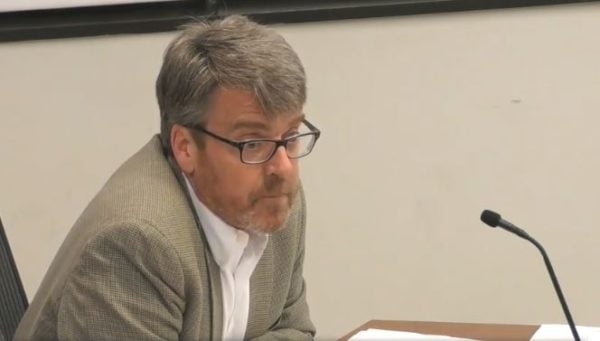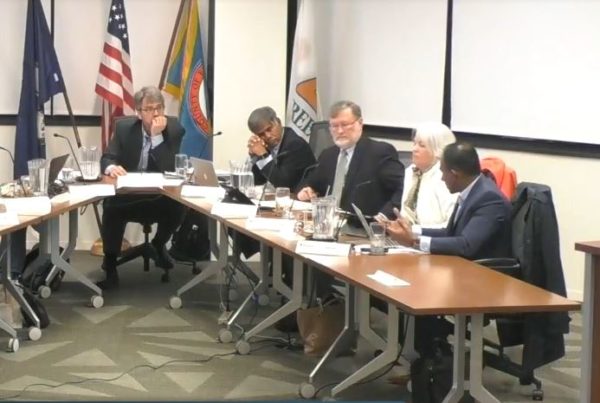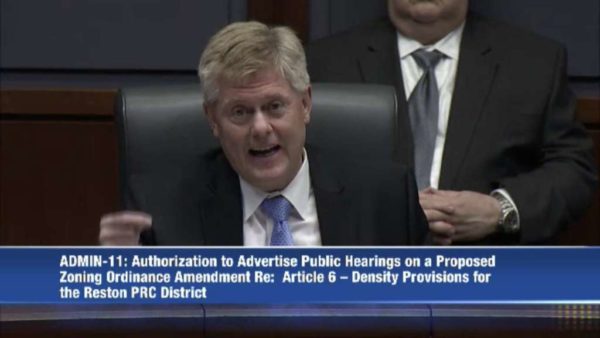(Update 5:00 p.m.) The soon-to-be-completed Reston Comprehensive Plan study is reviewing previous plans from 2014-2015 that say the Reston’s population is slated to more than double in the coming years, according to Hunter Mill District Supervisor Walter Alcorn.
Reston was home to an estimated 66,000 people in 2019, according to Fairfax County, which projects the population to jump to about 71,000 people by 2040. The existing comprehensive plan makes room for up to 157,000 people to eventually live in Reston — a 138% increase from 2019.
However, the RCP community task force is reassessing that number to see if it still remains appropriate.
“It’s definitely been an area of discussion for the task force,” Alcorn said at a briefing with local reporters on Friday (March 26). “The task force is making sure…the [RCP] infrastructure will be sufficient to manage that, both in terms of residential but also office workers and retail.”
Alcorn also noted that this population hike will have a notable impact on transportation and school capacity, elements that are continually part of the task force’s discussions.
The Fairfax County Board of Supervisors approved a review of the Reston Comprehensive Plan in January 2020, and the task force formed in May. The goal of the review is to analyze potential changes to the plan, which was last adopted in 2017 and guides future planning and land use decisions for the area.
The process was expected to take 12 to 18 months, but the pandemic may end up delaying the study’s completion by a few months. Alcorn said they are looking to wrap up by the end of the summer.
Chaired by Alcorn, the task force is made up of 32 members, including representatives from Reston Association, Save Our Sunrise, Reston Community Center, and Southgate Community Center.
In relation to anticipated population increases, the task force is also examining land use and areas where density might need to come down. Alcorn specifically noted Hunters Woods, South Lakes, and North Point village centers.
There’s also talk of having developers “earn” requested density by making commitments related to environmental impact and equity.
“How can new development, and the economic activity that comes with that, [make] connections…with underserved communities, communities in the Reston area that have not had the opportunity to fully take advantage of prosperity that comes with new development?” Alcorn said.
In terms of environmental footprint, Arlington County offers a similar exchange to developers, allowing extra density if they promise buildings will earn green building certification.
Alcorn noted that Reston could end up being a model for the rest of Fairfax County with what they are finding out from this study.
“Reston is exactly the right place to start these discussions in Fairfax County, given Reston’s history and Bob Simon’s principles,” Alcorn said.
The task force’s next meeting will take place on April 12.
Photo via Reston Association/Facebook
The Fairfax County Board of Supervisors is aiming to formally update its Workforce Dwelling Unit (WDU) policy to provide affordable rents for those in need as rents continue to increase across the region.
However, these policy changes would not apply to Reston, which is currently undergoing its own separate study to update its WDU policy. The proposal heads to the board for a public hearing and a vote today.
The main update is lowering the household income levels served under the county’s rental WDU program from a maximum of 120% of the Area Median Income (AMI) in the Washington D.C. Metro Area to 80% of AMI. It also now includes those at 70% and 60% of AMI in the program. The changes are based on a comprehensive staff report released last month.
The area median income (AMI) is the household income for the median household in a region. Currently, in the D.C. region, the AMI is $126,000 for a household of four.
“We conducted a housing strategic plan process over the last two or three years, which identified, sort of these lower incomes as being in the greatest need,” says Tom Fleetwood, Director of Fairfax County Housing and Development. “While at the same time, the higher income tiers that were served under the original version of the WDU program really were closer to the prevailing market rents here in Fairfax County.”
The updates would also lower the minimum percentage of rental units offered as WDUs from 12% to 8%. According to the plan, 4% of those units would need to be offered to those at 80% AMI, 2% to those at 70% AMI, and 2% to those at 60% AMI.
However, these numbers are different and are specifically revised for the Tysons Urban Center.
Fleetwood says the policy is “similar in intent” but the specific numbers are more in context with the realities of Tysons’ rental market.
In Tysons, developers would have the ability to choose between two different options for their affordable rental units. Either they can offer 2% of the units at 60% AMI, 3% at 70% AMI, and 8% at 80% AMI, which brings their WDU commitment to 13% in total, or they can simply offer 10% of their units at 60% of AMI.
The county’s planning commission voted unanimously to make these changes.
Reston is working on their own separate WDU study as part of the Reston Comprehensive Plan Study. That study is being initiated by a task force led by Hunter Mill District Supervisor Walter Alcorn.
Alcorn’s communication director Lisa Connors, tells Reston Now that Reston has a “separate formula for WDUs.” Similar to the policy updates that the county is voting on, WDUs will be discussed at the study’s task force meeting on March 8.
Affordable housing continues to be a challenge for Reston.
The Board of Supervisors is also voting to update, revise, and rewrite editorial elements of the policy that was first established in 2015. The revisions would update data, rework outdated terminology, and remove references to programs that no longer exist.
Photo by Mike Reyes/Flickr
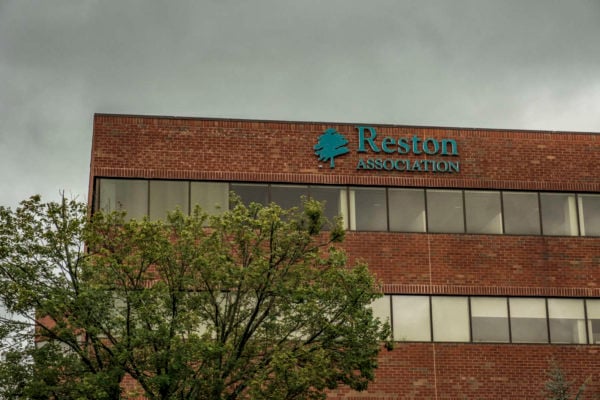
An update on Fairfax County’s Reston Comprehensive Plan Task Force is planned for tonight’s Reston Association Board of Directors meeting.
Established by the Fairfax County Board of Supervisors on Jan. 14, the Reston Comprehensive Plan task force has been tasked with reviewing the county’s Reston Master Plan, which guides land use, development, infrastructure, and the general vision and environment for the Reston community.
As a homeowners’ association that represents 21,346 residential units in the Reston community, Reston Association is represented on the task force by Secretary and North Point District director John Mooney with Chief Operating Officer Larry Butler serving as an alternate.
“There have been no decision points yet with the Reston Comprehensive Plan Task Force so the RA Board has not weighed in,” Mike Leone, Reston Association’s spokesperson said. “RA’s primary interest in participating on the task force is to ensure our members’ interests are heard during the task force process.”
Fairfax County originally amended Fairfax County Comprehensive Plan with a section specific to Reston in February 2014 to establish a vision for transit station areas created in anticipation of the arrival of Metro’s Silver Line.
The Board of Supervisors adopted a second phase of the Reston plan amendment in June 2015 to address the area’s village centers and residential areas, aligning the Comprehensive Plan’s recommendations with existing development.
While the Reston Comprehensive Plan was amended in 2018, the need to reexamine the plan more extensively emerged last year after county officials and residents clashed over a proposed zoning ordinance amendment that would have increased the density limits for Reston’s planned residential community district.
The proposed zoning amendment was intended to ensure Reston will be able to accommodate anticipated future growth, but many residential groups, including Reston Association, Reston 20/20, and the Reston Citizens Association, argued that it would be more effective to modify the comprehensive plan before considering changes to the PRC district density limits.
The Fairfax County Planning Commission ultimately agreed with opponents of the proposal, voting unanimously in February 2019 to recommend that the county supervisors do not amend the zoning ordinance until an amendment to the Reston Comprehensive Plan is in place.
The Board of Supervisors voted that March to indefinitely defer the proposed zoning ordinance change.
After taking office in January, Hunter Mill District Supervisor Walter Alcorn moved to establish the Reston Comprehensive Plan task force, which consists of 24 members with seven alternates and held its first meeting on May 11.
At its last meeting on Sept. 14, the task force tentatively approved topic areas, reviewed the comprehensive plan’s planning principles, and got an overview of transportation issues in Reston from Fairfax County staff, according to meeting materials.
Alcorn, who is facilitating the task force, says the group has also discussed Reston’s projected population and planned transportation improvements.
“After five meetings and 10 hours of engaged discussion, I am very excited about the work being done by the task force,” Alcorn said. “The task force is really just getting started and participation from interested members of the community is encouraged. The output of this work will guide Reston’s built and natural environment for decades to come.”
With the comprehensive plan review and community engagement process expected to take between 12 and 18 months, the task force has scheduled meetings through December, with the next one set for Sept. 30.
Other notable items on tonight’s agenda for the RA Board of Directors include:
- Approval of the proposed work plan for the multimodal transportation committee, which gives advice and policy recommendations on transportation infrastructure related to Reston
- A third-quarter information technology update, including information about the association’s new website
- A status update on completed, ongoing, and upcoming RA capital projects, including an overview of funding for its Lake Thoreau project
- A progress update on the recreation facilities working group, which is evaluating the condition, usage, and costs of the association’s recreational facilities
According to a summary in tonight’s agenda, the cancelation of camps, programs, and events, along with a shortened pool season, have had the most significant financial impact on Reston Association, lowering operating expenses by $2 million to offset a $1.5 million drop in revenue as of August.
Staff Photo by Jay Westcott
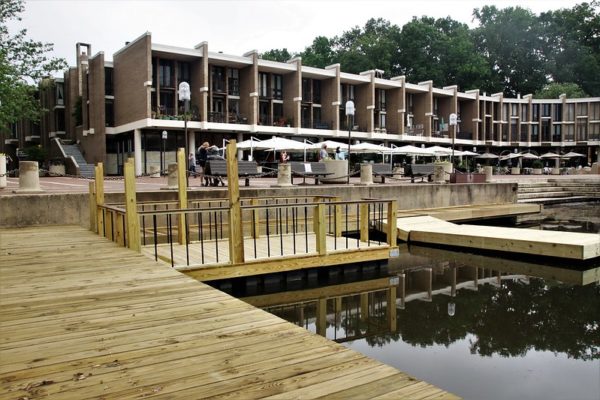
Planning for Reston’s Ultimate Population — “In discussing the need for the plan study, Alcorn acknowledged that most of the initial planning of Reston was based on the master plan Robert Simon created when he established the community in the 1960s. It’s only been in the last decade or so, as Reston has undergone redevelopment, that comprehensive plan language has been updated.” [Reston Patch]
Man Assaulted on North Shore Drive — A man was treated for injuries at a local hospital after two men assaulted him on the 11400 block of North Shore Drive at around 1:11 a.m. [Fairfax County Police Department]
Reston Firm Acquired by French Company — “Reston-based managed security firm Paladion will be acquired by Bezons, France-based information technology company Atos. A transaction amount was not disclosed.” [Virginia Business]
Photo via vantagehill/Flickr
Though the work to update Reston’s comprehensive plan was slowed by COVID-19, Hunter Mill District Supervisor Walter Alcorn said that a new committee created to find solutions to issues and demands is still making progress.
The roughly 28-person task force started meeting in early April, a month after originally planned, and has spent over eight hours in meetings, according to Alcorn.
So far, the committee has touched on topics such as:
- ways to promote public art
- how to encourage diversity and inclusion
- long term population accommodations
- community space and land use
Since Alcorn’s election, he said that the revision of the comprehensive plan was his top priority. “There were a lot of things that were left out and need additional attention.”
As phase two of the Silver Line makes the area more accessible to the greater D.C. region, it has “coincided with some really strong economic activity,” Alcorn said at a press conference on June 25. He added that the number of technology companies and government contractors has increased, meaning that the original community plan put forward by Bob Simon is in need of revision to accommodate changes.
Though some see economic growth as a positive opportunity others disagree since they don’t like the “cookie-cutter, industrialized subdivisions that we have seen around many metropolitan areas in the country,” Alcorn said, noting that Simon’s idea focused around a tight-knit community feel.
“We’ve been through a time where different parties have staked out their territory and if anything this is like a truth and reconciliation process,” Alcorn said, adding that it has been a type of “growth war.”
Despite concerns of community members, Alcorn said he sees an opportunity to build other hubs around transit centers in the area that are responsibly designed, sustainable and attractive so they don’t negatively affect the preexisting Reston community.
In the comprehensive plan, there is currently no population plan for Reston’s build-out and though there has been an attempt to take that into consideration in zoning ordinances, this isn’t enough, according to Alcorn — since it doesn’t cover the entirety of the community.
Though Alcorn didn’t get into the weeds about public art at the committee meeting, he said this will help to promote the original ideals and morals of the area, noting that he wants to stay away from the “industrialized” feel.
Going forward, Alcorn said he sees finalized changes being made to the comprehensive plan around the middle of 2021. “That’s the target, to have this wrapped up next year.”
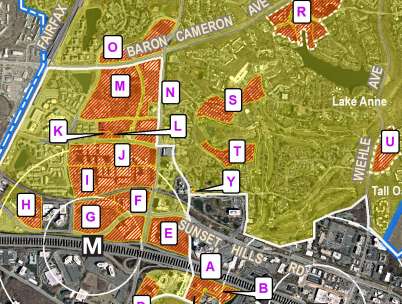
Work on updating the Reston Comprehensive Plan is underway as the inaugural meeting of a planning task force kicks off next month.
The Reston Comprehensive Plan Task Force, which includes residents, business and industry professionals, and other individuals, will meet virtually on May 11.
Taskforce members are expected to be announced later this work, according to Hunter Mill District Supervisor Walter Alcorn’s office.
“There is a lot of work to be done so we will schedule meetings every two weeks,” according to Alcorn’s most recent newsletter.
In his first board matter in January, Alcorn initiated the public participation process to begin mulling changes to the plan, which was last updated five years ago.
Alcorn has stated that updates to the plan will need to consider the most appropriate balance between current and future development, infrastructure, and the environment.
Since the plan was last adopted, more than 30 rezoning applications have been approved by the county, including major placemaking applications in Reston transit-oriented areas.
The review and public engagement process is expected to take up to 18 months.
The plan, which guides the pace and nature of development was first adopted in July 1962 and updated periodically since then.
Handout via Fairfax County Government

Hunter Mill District Supervisor Walter Alcorn: Reston Master Plan Review Delayed — “We’ve had to delay initiation of the planned task force process,” Alcorn said, Wednesday morning during a video call with reporters. “We’ve heard from a number of folks who had volunteered to be on a task force. I don’t expect we’re going to initiate any task force activity until we make sure we can have a robust process.” [Reston Patch]
Distinguishing Between Social Distancing, Quarantine, Self-Isolating — Social distancing refers to staying out of congregate settings, avoiding mass gatherings and maintaining distance from others when possible. Self-Isolating refers to staying at home, not going out, and not accepting any visitors. [Fairfax County Government]
Three Inova Respiratory Illness Clinics Open — Three Urgent Care locations in Dulles South, North Arlington and Tysons will conduct physician-ordered tests and evaluate patients with respiratory illness symptoms. [Fairfax County Government]
Photo by Marjorie Copson

Hunter Mill District Supervisor Walter Alcorn kicked off his first Fairfax County Board of Supervisors’ meeting today (Tuesday) by calling for a review of Reston’s Comprehensive Plan.
The proposal, which was approved by the board, initiatives a 12 to 18 month period of public engagement to update the plan, which was last updated five years ago.
In a statement, Alcorn noted that more than 30 rezoning applications have been approved in Reston’s transit station areas since the last plan was last reviewed. He hopes to set up a community task force and start a series of public meetings.
Alcorn hopes to tackle the following topic areas, which were presented to the board today (Tuesday):
- Projected population thresholds for Reston, and how to ensure that population, infrastructure and the environment are all in balance
- Land use in the village centers (Hunters Woods, South Lakes and North Point) – including clarification of what type of future redevelopment proposals might require an amendment to the Comprehensive Plan
- The adequacy of existing plan language to generate additional affordable housing, and improvements to plan language to encourage preservation and enhancement of existing communities that now provide affordable housing
- The adequacy of existing and planned pedestrian and bicycle infrastructure for accessing Silver Line stations
- The adequacy of existing Comprehensive Plan guidance to facilitate urban-scale mobility and development design in the TSAs while protecting the stability of nearby neighborhoods
- Existing Comprehensive Plan transportation improvements to ensure that they are aligned with planned development
- How the Comprehensive Plan could better facilitate enhancement of Reston’s natural environment, encourage energy efficiency and support sustainable green neighborhoods
- How the Comprehensive Plan could address concerns about monopolization of ownership in Reston, and ways to encourage diverse ownership and/or management over the long term
- Whether the historic practice of promoting privately-owned and managed open space sufficiently addresses public needs during the next 50 years of Reston
In a previous interview with Reston Now, Alcorn said he hopes updates to the plan will help better manage growth and infrastructure in the rapidly changing community.

Walter Alcorn, the incoming Hunter Mill District Supervisor who won a five-way Democratic primary, plans to prioritize managing growth and infrastructure as he takes over for retiring Cathy Hudgins on Jan. 1.
As cranes scrape the skies and community consternation about development continues to rumble, one of Alcorn’s top priorities is to update and improve Reston’s major planning document — phase two of Reston’s comprehensive plan.
“Our biggest challenge is clearly managing the growth that we’re undergoing right now, both in terms of mobility and change and our quality of life,” Alcorn said in a recent interview with Reston Now.
He hopes to incorporate measures that manage growth and infrastructure — including population projections that can guide infrastructure needs, planning for public facilities like transportation and schools, and expectations for public open space. Alcorn also hopes to incorporate language to preserve existing affordable housing and clarify expectations surround the future redevelopment of Reston’s village centers, some of which are in need of revitalization.
Although Alcorn has not pitched specific recommendations — a public feedback process in early 2020 will guide the community conversation — the Democrat has one specific idea: breaking up the ownership of Reston Town Center.
Alcorn says the county can incorporate language in the comprehensive plan to “call for diverse ownership of Reston Town Center” in order to break up the “monopolistic” ownership of Reston’s core from Boston Properties. The move would address concerns related to vacancies and the departure of small businesses following the company’s seismic shift to paid parking in 2017.
For now, the controversial discussion on increasing Reston’s population density per acre in the Planned Residential Community district — the community’s primary zoning district has been indefinitely delayed.
Alcorn believes the county should reexamine Reston’s comprehensive plan before reconvening discussions on the tabled PRC proposal.
“We need to fix the comprehensive plan,” Alcorn told Reston Now. “My first priority is to fix the comprehensive plan.”
He also wants to explore ways to streamline how Reston-related development proposals are reviewed, particularly between the Hunter Mill District Land Use Committee, which advises the supervisor’s office on land use issues, and the Reston Planning & Zoning Committee. Possible proposals include improving the public input process, adding county staff support to attend meetings and improving the sequencing of the multi-step approval process.
“Many times, these groups are asked to make recommendations on zoning before they can even see proffers associate with rezoning,” he said.
Other county-wide initiatives Alcorn hopes to take a lead on include:
- A land use reform initiative to create affordable housing opportunities, in conjunction with other supervisors
- Efforts to improve pedestrian mobility through regional initiates and more comprehensive planning beyond the county’s bicycle master plan.
As he begins his term on Jan. 1, Alcorn hopes to leverage his experience as a former planner with the county to ensure the vitality and promise of Reston remains.
“I come to this job with good knowledge of the land use process and also a commitment to engage the public and the community in that land use process,” he says. “We’re at an interesting time in Reston with transit-oriented development underway and older communities that are in need of retention. That is something that is new.”
Photo via Facebook
 This letter was submitted by Terry Maynard, who resides in Reston. It does not reflect the opinions of Reston Now. We publish article and opinion contributions of specific interest to the Reston community. Contributions may be edited for length or content.
This letter was submitted by Terry Maynard, who resides in Reston. It does not reflect the opinions of Reston Now. We publish article and opinion contributions of specific interest to the Reston community. Contributions may be edited for length or content.
As a Restonian who has worked hard on Reston planning and zoning for more than a decade, I was stunned by the letter mentioned in a recent Reston Now article. It was signed by 17 people — many of whom are associated with the leadership of the Greater Reston Chamber of Commerce (GRCOC) — to Hunter Mill District Supervisor Cathy Hudgins.
One of the most stunning claims in the letter was that “Reston’s Comprehensive Plan was the product of a five-year planning process involving the full community.” The fact of the matter is that the Reston community was marginalized throughout this timeframe, and its contributions were opposed by developers and ignored by the county.
No community representative, then or now, has opposed reasonable residential and commercial development in the transit station areas. They have objected and continue to object to the excessive development proposed by private and county land use interests.
Only six of the two dozen primary members of the RTF studying Phase 1 for the transit station areas were Reston residents who represented the interests of Reston residents. They included representatives from three community organizations — Reston Association, Reston Citizens Association and Alliance of Reston Clusters and Homeowners — and three independent “at large” residents.
The Task Force recommended 27,932 dwelling units — homes for about 59,000 people — in the station areas based on a study of multiple density and mix scenarios — a development level community representatives could live with. That was set at 27,900 when the Board of Supervisors (BOS) approved the Phase 1 plan in early 2014 — a number Reston community representatives could live with.
Then that Phase 1 planned station area dwelling unit number was raised by more than half to 44,000 dwelling units — 92,000 people — in mid-2015 by the BOS in the process of approving the Phase 2 plan without any community involvement or even foreknowledge. Yet the county insists it only revises plans every five years.
Community involvement in Reston planning was even more limited during Phase 2 for Reston’s suburban areas. It included only four county-led and controlled community meetings and an open house. It was agreed that residential areas should remain “stable,” but the redevelopment of Reston’s village centers drew controversy. Draft county language to require a comprehensive plan amendment to redevelop village centers was dropped from the Board-approved mid-2015 Reston Master Plan because it would make the redevelopment approval process more cumbersome. This effectively shut off public comment on critical changes and eases development.
No meaningful commitment was made in the Reston Master Plan to provide needed infrastructure on a timely basis, despite the GRCOC letter saying, “The Plan requires that infrastructure be ‘phased’ with development.” In fact, that is illegal in Virginia and the RMP planning principles say it “should occur with development.” Language about specific infrastructures–transportation, schools, parks, etc., is vague and the proposals are inadequate.
Moreover, no meaningful funding has been committed to building any of the so-called “planned” infrastructure elements, which are all generally inadequate against even county policy standards, excluding the library where a $10 million bond funding may disappear in 2022.
Now the county is proposing to amend the Reston Planned Residential Community (PRC) zoning ordinance to increase allowable community-wide population density from 13 to 15 people per acre in suburban Reston and increase the allowable density on a single PRC property designated “high density” from 50 to 70 dwelling units per acre, including the village centers and several so-called “hot spots.” In its staff report on the proposed zoning density change, the county calculates roughly a quadrupling of planned housing in the village center areas from less than 1,500 to 5,800.
It also identifies three suburban residential “hot spots”– Saint Johns Wood, Charter Oaks and Fairway — for high-density redevelopment that would more than double the number of dwelling units to 1,863 residences.
The bottom line is that Restonians have had — and continue to have — limited access to the planning and zoning process throughout and their contributions and concerns have almost universally been ignored.
The cumulative effect of the new zoning in the station areas and the prospect of increasing the Reston PRC zoning density would be to allow Reston’s population to triple from its current 63,000 people to more than 180,000. At the same time, there is little or no assurance of the arrival any time soon of needed infrastructure that would maintain Restonians’ quality of life as a model planned community.
Now it is imperative that Restonians rise up and stop the county’s ill-considered PRC density increase proposal driven by Supervisor Hudgins. Attend the Planning Commission hearing on the PRC amendment at 7 p.m. on Jan. 23 in the Fairfax County Government Center wearing a yellow shirt. The presence of hundreds of Restonians will be as great a message to the Planning Commission as the testimony of Reston’s representatives and residents.
— Terry Maynard
File photo
 This letter was submitted by Bruce Ramo, a member of community groups Reclaim Reston and Coalition for a Planned Reston. It does not reflect the opinions of Reston Now. We publish article and opinion contributions of specific interest to the Reston community. Contributions may be edited for length or content.
This letter was submitted by Bruce Ramo, a member of community groups Reclaim Reston and Coalition for a Planned Reston. It does not reflect the opinions of Reston Now. We publish article and opinion contributions of specific interest to the Reston community. Contributions may be edited for length or content.
It’s a lot to ask of everyone in Reston to understand the minutiae of land use law. We have families and jobs and other responsibilities. And, after all, we chose to live in a planned community with loads of covenants and design guidelines. We can leave it to the “experts.” Except we can’t.
Like it or not Restonians have little say over how our community is being developed, and the elected official who should be watching out for us, our county supervisor, has retreated to a defensive posture. She frequently tells us “we just don’t understand” and has suggested that Reston, perhaps the most progressive community in Virginia, opposes the proposed increase in the density cap out of fear of “the other” sharing our neighborhoods. This is simply untrue. The community group Coalition for a Planned Reston proposed an increase in the required affordable housing levels for Reston–our supervisor did not support us.
So what’s the big deal about increasing the density cap, from 13 to 15 persons per acre, in the primarily residential areas of Reston called the Planned Residential Community district? The supervisor and county staff tells us that the increase is necessary to implement 2015 changes to the Reston Master Plan. Those changes allow significantly increased density in the Village Centers and other “hot spots” throughout established neighborhoods of Reston, far from the Metro stations. We are also scolded about speaking up now because, as the story goes, the public had lots of opportunities back in 2014-15 to comment on changes to these portions of the Reston Master Plan changes called “Phase 2.” (Phase 1 involved only the transit station areas.)
Our supervisor and county staff frequently repeat the myth of significant community involvement in Reston Master Plan Phase 2. However, the county disbanded the citizen “task force” set up for community review before the Phase 2 review. There simply was little in-depth public review of the changes that are the driver for increasing the density cap.
Why should you care? Because if the zoning density cap is lifted, the ability of the community to push back on significant high-density development in our established residential neighborhoods effectively will be eliminated. Sure, each of us can watch out for individual development applications, but the force of overall community oversight based on a reasonable density cap will have been taken from us forever.
We have invested our financial resources, identities and emotional loyalty to Reston as a planned community. The density increase is an existential threat to those investments.
Take action to protect your hometown. Help maintain the current density cap and the modicum of control it provides over those who would rob us of a community grounded in diversity, environmental stewardship and quality of life.
Attend the Jan. 23 meeting of the Planning Commission at the Fairfax County Government Center at 7 p.m. (and wear your yellow shirts!)
Write to our County officials: Supervisor Hudgins: [email protected]; other Fairfax County Supervisors: [email protected]; and the Fairfax County Planning Commission: [email protected].
File photo
 This letter was submitted by Dennis K. Hays, the president of the Reston Citizens Association. It does not reflect the opinions of Reston Now. We publish article and opinion contributions of specific interest to the Reston community. Contributions may be edited for length or content.
This letter was submitted by Dennis K. Hays, the president of the Reston Citizens Association. It does not reflect the opinions of Reston Now. We publish article and opinion contributions of specific interest to the Reston community. Contributions may be edited for length or content.
Fairfax County has proposed to increase the population cap of the Reston Planned Residential Community district (PRC) from the long-standing 13 persons per acre (ppa) to as many as 15 persons per acre — which when combined with already approved projects would add an additional 30,000 people above our current population for the established, primarily residential areas of Reston. Please keep in mind this doesn’t include the areas around the Metro, where the county is on track to authorize building enough high rises to add an additional 80,000 residents.
Here are 10 reasons why the cap should be left alone. There undoubtedly are more.
1. If the ceiling (13) is shattered, there is no new ceiling: Fourteen or 15 today will be 16 tomorrow, 17 the day after and 20 down the road. The current 13 ppa has been in effect since Robert Simon created Reston. Does anyone believe the county will stop at 15?
2. The county bases its proposal on numbers that are rough estimates at best, gross misrepresentations at worst. The county has provided no established methodology that can be used to arrive at accurate numbers. The county promised to meet with the Coalition for a Planned Reston (CPR) and the Reston Association to agree on a methodology before any action would be taken. We’re still waiting.
3. There are thousands of dwelling units (what the county calls where we live) that have been approved but not yet built (1,400 at Spectrum alone). How will all these already authorized residences affect roads, schools, first responder services, and parks? The county counts them for cap purposes, but not for the provision of services.
4. The county doesn’t count people who live in affordable or workforce housing as part of the cap, despite CPR’s frequent complaints. These neighbors of ours have kids in school, drive to work, go to the library and play ball in the parks just like everyone else. So why are they second-class citizens in the county’s eyes?
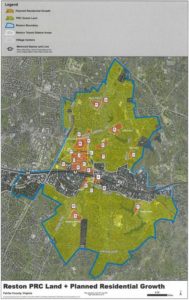 5. Although the county is in a frenzied hurry to authorize new high-density construction, they are in no hurry to provide the needed infrastructure that should go along with it. Reston has received no funding from the county in its current transportation budget. There is no land for additional athletic fields or open space confirmed. The Master Plan calls for infrastructure to be phased in with development. County officials talk for hours about their “plans” for roads, schools, parks, etc. but when pressed they are forced to admit they have no funds, no identified land and no timetable for the required infrastructure.
5. Although the county is in a frenzied hurry to authorize new high-density construction, they are in no hurry to provide the needed infrastructure that should go along with it. Reston has received no funding from the county in its current transportation budget. There is no land for additional athletic fields or open space confirmed. The Master Plan calls for infrastructure to be phased in with development. County officials talk for hours about their “plans” for roads, schools, parks, etc. but when pressed they are forced to admit they have no funds, no identified land and no timetable for the required infrastructure.
6. Why the push to raise the cap now? Even using the county’s questionable numbers there aren’t any development proposals that take us over the 13 ppa limit. So what is the rush? Why not use this time to assess how we grow in phase with the services needed to support our neighborhoods?
7. Until five years ago the county had an official on the Planning staff dedicated to working on Reston proposals. This provided some coordination. They haven’t replaced that official. Now the county can’t say specifically where the development allowed by their increased cap will go, although it doesn’t take much to figure this out — initially it will go to build high rises in the Village Centers, take parking spaces away from the library and push again on St. Johns Wood and the other “hot spots” the county believes should be more urban. And by urban they mean you will only walk, bike or Metro to work, the grocery store, the movies, to see family and friends and everywhere else. And then they will come for the golf courses.
8. The Reston Master Plan was changed in significant ways after community representatives had signed off on what they believed to be the final version. Leaving that aside for the moment, the Virginia Code calls for Master Plans to be reviewed and updated at least every five years. The Master Plan for the Metro areas is up for review next month. The PRC portion must be updated no later than next year. Yet the county has taken no steps to begin the review process. Given all that has happened, isn’t it time to pause and take stock?
9. The more you dig into the county’s assertions, the shakier they become. The CPR and the Reston Association met with county officials in four sub-groups last summer. It became immediately apparent that a lot more information and data was needed to properly review and assess the issues surrounding the cap. We had agreement coming out of all four meetings that the additional information would be developed before any action on the cap was taken. CPR and RA asked over 30 specific questions. On Dec. 11 the county responded by sending a blizzard of paperwork — that restated what we had already been told but provided no new information. Why hasn’t the county met its commitment to answer these questions? Could it be that the answers would be more damning than not answering?
10. The county speaks often of the need for “community involvement” and the Master Plan lists community participation as the foundation stone on which all else rests. So why has the county refused to meaningfully engage with its citizens? We remain ready to work with the county to further the unique vision of Reston as a balanced, welcoming community that takes to heart our motto of “live, work, play.” Is that too much to ask?
If you agree that raising the cap is unneeded and counterproductive, please let our Fairfax County Supervisor ([email protected]), the other supervisors ([email protected]), the Planning Commission ([email protected]) and the Department of Planning and Zoning ([email protected]) know. We can make this a Happy New Year if we act together.
— Dennis K. Hays
Updated at 5:00 p.m. — Corrects the spelling of Laurie Dodd’s name and the time of the Planning Commission meeting on Jan. 23.
Reston Association’s Board of Directors unanimously voted to continue its opposition to a proposed zoning amendment, which would increase Reston’s population density, at last night’s meeting.
The proposal would increase the maximum allowed population per acre in the Planned Residential Community (PRC) district — Reston’s primary zoning district — from 13 persons up to 15.
After an executive session to consult with the land use counsel, Vice President Sridhar Ganesan said that the current density at 12.46 people per acre is a “very inaccurate population estimate.”
“A lot of slack is built into the current density,” Ganesan said. “I believe the director of the Planning and Zoning Commission told us –some of the members on the board — they are trying to recalculate the population estimate in Reston, and they don’t have an accurate estimate just yet.”
Given the wiggle room in the current density and the outrage from many community members, Ganesan said the PRC density level should not increase.
Several community groups, including the Coalition for a Planned Reston and Reston 2020, are fighting the move, arguing that the proposed amendment is rushed through and under-explained.
County planning officials have argued that the change is needed to put into action Reston’s Master Plan, which allows for future growth over the next 40 years.
President Andy Sigle said that the RA is still working through “reams” of data and information in support of the zoning proposal from a series of emails on Dec. 11 from Fairfax County.
“We have a concern that the wrong number on this PRC density will overwhelm the infrastructure prescribed in the Reston Master Plan, so it’s important that we get the right number,” Sigle said at the meeting.
 The board also approved setting up a work session for RA’s board prior to the Planning Commission’s Jan. 10 workshop on the amendment.
The board also approved setting up a work session for RA’s board prior to the Planning Commission’s Jan. 10 workshop on the amendment.
Fairfax County’s Board of Supervisors clashed over community input on the proposed zoning changes at their Dec. 4 meeting, before authorizing public hearings on the proposal.
Hudgins said at the Dec. 4 meeting that locals have had plenty of opportunities to get the desired information. “Yes, there are some questions that people have,” Hudgins said. “Those questions have been answered before or are not relevant to this.”
Meanwhile, Dranesville District Supervisor John Foust and Braddock District Supervisor John Cook argued for more community input.
Residents expressed frustration and disapproval to RA’s board last night (Dec. 13), pointing to a lack of community input to the county’s board and insufficient infrastructure to support increased density in Reston.
Laurie Dodd, a resident for the last 23 years, criticized Hunter Mill District Supervisor Cathy Hudgins for asking to schedule hearings on the zoning proposal without following through on promised community engagement.
“It is disturbing to me to see other supervisors in Fairfax County speak up about the right of residents to be heard more than our own supervisors had done,” Dodd said.
The Planning Commission is scheduled to hold a public hearing about the zoning proposal at 7 p.m. on Jan. 23, followed by the Board of Supervisors’ public hearing at 4:30 p.m. on March 5.
The Planning Commission must say “yea” or “nay” to the proposal by March 15, according to county rules.
Secretary John Mooney urged Restonians to stay informed and engaged. “Please attend the county meetings,” he said.
Photo via Reston Association/YouTube
This story has been updated
Reston Association is set this week to take up contentious proposed zoning changes that would increase the population density in Reston.
This upcoming meeting will focus a motion to oppose the zoning proposal and also consider approving $22,500 from its cash reserves to increase next year’s staff training budget at the public meeting tomorrow (Thursday) at 6:30 p.m. at RA’s headquarters (12001 Sunrise Valley Drive).
The proposal would increase the maximum allowed population per acre in the Planned Residential Community (PRC) district — Reston’s primary zoning district — from 13 persons up to 15. The current density is roughly 12.46 people per acre.
County planning officials have argued that the change is needed to put into action Reston’s Master Plan, which allows for future growth over the next 40 years.
Several community groups, including the Coalition for a Planned Reston and Reston 2020, are fighting the move. They argue that the proposed amendment is rushed through and under-explained.
Fairfax County’s Board of Supervisors clashed over community input on the proposed zoning changes at their Dec. 4 meeting, before authorizing public hearings on the proposal for 7:30 p.m. on Jan. 23 and 4:30 p.m. on March 5.
On the heels of adopting the 2019 operating and capital budgets for next year, RA’s Board of Directors will also consider whether or not to use $22,500 from the operating reserve funds for 2018 to expand the 2019 fiscal year budget for staff training and development.
The RA also will consider revisions to the third draft of the election schedule and receive the treasurer’s report. RA is also set to approve Sharon Canner as the chair of the 55+ Advisory Committee and Nancy Malesic as a member of the Environmental Advisory Committee.
The draft agenda for the meeting is available online.
Photo via Reston Association/Reston Today
Fairfax County’s Board of Supervisors disagreed about community input on contentious proposed zoning changes, before authorizing public hearings early next year on the changes at their meeting today.
The proposal, which would increase the population density in Reston, has sparked a backlash from community groups, including the Reston Association, Coalition for a Planned Reston and Reston 2020.
County planning officials have argued that the change is needed to put into action Reston’s Master Plan, which allows for future growth over the next 40 years.
Dranesville District Supervisor John Foust vented frustration at the Dec. 4 meeting that Reston residents have not heard back from the county regarding the public hearings for the zoning proposal.
In response to Foust’s concerns, Hunter Mill District Supervisor Cathy Hudgins said that locals have had plenty of opportunities to get the desired information.
County officials began small workgroup sessions hosted by the Coalition for a Planned Reston, a grassroots organization, and the Reston Association in July to discuss the controversial plan.
“Yes, there are some questions that people have,” Hudgins said. “Those questions have been answered before or are not relevant to this.”
Hudgins stressed that consideration of the proposed zoning changes is moving forward because of the work, including 13 follow up meetings since May and regular meetings with the Reston Association, already done.
Hudgins praised the “noble” staff for answering community questions.
Braddock District Supervisor John Cook said that verbal responses from staff to locals are not enough, adding that the community would benefit from written questions and answers available online.
“I don’t think it’s enough to have oral questions,” Cook said. “Not everyone can get to public meetings.”
Cook added that community input must have limits. “It’s fair to have a cut off date for questions,” he said.
The Fairfax County Planning Commission has 100 days from the referral — the staff report published Dec. 4 — to take action on the zoning proposal. The Board of Supervisors authorized public hearings on the zoning changes for 7:30 p.m. on Jan. 23 and at 4:30 p.m. on March 5.
“The clock starts today,” Lee District Supervisor Jeff McKay said.
.@johnfoustva venting frustration that Reston residents not hearing back from @fairfaxcounty when it comes to advertising public hearings for zoning ordinances. To which the Dept. of Planning/Zoning places blame on Reston—never guaranteed response to every inquiry. Wow, not good! pic.twitter.com/bAcnJ3jtPh
— Fairfax County Memes (@FairfaxMemes) December 4, 2018




